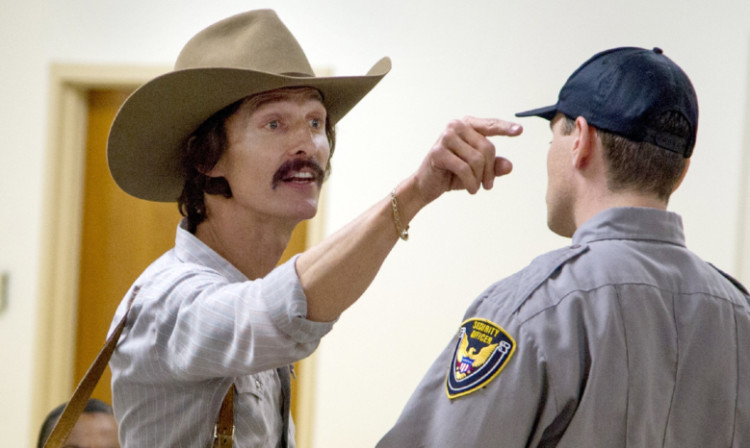
Matthew McConaughey is in line for an Oscar due to his remarkable portrayal of an AIDS sufferer in Dallas Buyers Club.
Matthew McConaughey doesn’t have HIV or any other life-threatening disease.
One of the reasons for the clarification is because the actor, once known for romantic comedies and action movies, gives a startlingly realistic portrayal of AIDS sufferer Ron Woodroof in Dallas Buyers Club.
It’s so good that Matthew, who shed three and a half stone to play the terminally ill Woodroof, has won the Golden Globe and Screen Actors Guild awards for Best Actor and is hot favourite to complete the set when he attends next month’s Oscars ceremony.
The only reason he won’t also have a BAFTA on his mantelpiece is because the film’s February UK release meant the film missed the entry deadline. There’s always next year.
But there was another incentive for me wanting to ascertain Matthew’s state of health when I met up with him at Claridge’s Hotel in London last week.
Since disappearing off the radar in 2010, Matthew has returned with the same determination and drive that made the last years of Ron Woodroof’s life a compelling enough story to be turned into a film.
“You see it so often when people come up against the greatest opposition death and they really come alive,” agrees Matthew, who reassures me he’s put most of the weight back on.
“Why does it take that? I looked at my own life and thought of the important things that have made me become a man. My father dying was certainly one of them, so it’s interesting what it does to us, either facing death ourselves or having someone close to us die.
“For Ron, it gave him focus. I was given his diaries by his family and before he got sick he was just a drifter. He found a purpose, a drive, and something to fight for when he got HIV.”
The incredible story begins in 1985 when rodeo rider Ron was diagnosed with HIV and given 30 days to live.
Those that did know of the disease in Ron’s macho, womanising world referred to it as “the gay plague” so when one of their own was diagnosed he found himself ostracised by his best friends. But Ron was stubborn and wasn’t happy with the first, second or third opinion he received from doctors.
He travelled to Mexico where he’d heard of a treatment, a cocktail of vitamins and alternative medicines, which people there were experimenting with.
As Ron stretched his life expectancy from days to months to more than a year, he felt other HIV sufferers should have access to the same treatment.
This meant ingratiating himself with Texas’s gay community and forming an unlikely business partnership with transgender AIDS patient Rayon, played by fellow Oscar nominee, Jared Leto.
“He didn’t have this ‘Oh my God, I need to apologise for who I was’ epiphany that we see in many films of this type,” 44-year-old dad-of-three Matthew explains of the subtle change in Ron.
“He’s essentially the same S.O.B. you see at the start of the film, but that’s what kept him alive. It would have been false to make him out to be any different.
“What we’ve found with audiences is that at the start of the film they’re saying: ‘I can’t stand this guy’. But then he comes up against authority and death and you start to root for him. That’s human nature.”
The villain of the piece is the US Food and Drug Administration who took Ron to court to stop him importing the drugs that were keeping him and many others in his “Dallas Buyers Club” alive.
They’d signed a deal with a company to produce AZT, the most expensive drug ever bought to market in 1987, costing more than £6,500 for a year’s supply. They weren’t happy to have a cheaper competitor showing more promising results.
But back to Matthew, and the real reason for his career hiatus and incredible turn around in fortunes since his return with films such as The Lincoln Lawyer, Mud and now Dallas Buyers Club.
“I did make a decision to say no to roles that were similar to what I’d been doing,” he tells me.
“Before I said: ‘This is what I want to do’, I had to say, ‘This is what I don’t want to do’. Somewhere in that impasse, which was about a year and a half where nothing came in, I gained a little anonymity, and it became a fresh idea for people to cast me.
“I switched gears and said I wanted to recalibrate what I do in my career. I’ve enjoyed the last 22 years. I’m not arrogant enough to boo hoo anything I’ve done in my career.”
In three weeks time, Matthew will most likely have a heading for his new chapter in his life Oscar winner.

Enjoy the convenience of having The Sunday Post delivered as a digital ePaper straight to your smartphone, tablet or computer.
Subscribe for only £5.49 a month and enjoy all the benefits of the printed paper as a digital replica.
Subscribe